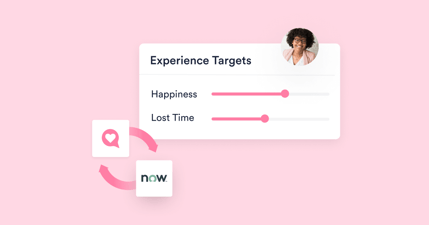There’s a lot of IT industry buzz about experience level agreements (XLAs) or experience-based metrics right now. But what does your organization need to do to succeed with them?
Getting practical XLA success tips from people who have already successfully implemented and benefited from experience management capabilities can be challenging. To help, this blog shares some practical tips experienced XLA authority Dean Underwood offered in a Succeeding with XLAs presentation.
Before the tips, though, it’s worth looking at an example of Dean’s results from using XLAs.
Example benefits from XLA and experience management use
At Poundland & Dealz, experience data brought about four key changes:
- Any channel IT support
- Data-driven automation
- A Virtual TechBar approach
- Service desk upskilling
The better outcomes from these changes included:
- Service desk resolution rates increased by 32%
- 15% automated resolution on the email channel
- NPS increased by 30% within eight weeks
- A 33% reduction in service requests during employee onboarding.
Practical tips for succeeding with XLAs
The following 15 tips are “sucked” from Dean’s presentation in the order that they were delivered. Please watch the presentation recording for more details of what each tip entails.
- Understand your business and what’s important to its stakeholders. Identify what your business needs in terms of outcomes.
- Get your teams thinking about and using practices focused on how what they do impacts their business’ products and services. Focus on how people consume what you deliver rather than just delivering it to them.
- Ensure that your team understands why change is needed, what the aim is, and what that change involves.
- Set customer/employee experience as the main measure of success. Focus on outcomes, offer the channels the business wants, and understand what makes the customer happy.
- Map out customer journeys to understand what happens when people come to you for help. If you don’t know what your customers want from you, how can you deliver your service? Remember, “If you don’t understand it, how can you build it?”
- Use the experience data and customer feedback to map the customer journey to identify the value streams and areas to target.
- Don’t assume you know employee expectations and their desired experiences. For example, Dean found that new employees would wait for a laptop as long as it fully worked once received, i.e. a fully working laptop after ten days was deemed better than an immediate one that didn’t fully work.
- Empower people to make process changes and give them responsibility for the outcomes.
- You have to think about things differently. For example, first-contact resolution is an industry perspective. Some end-users might be happy to stay on the phone until their issue is fixed, while others might not.
- Don’t worry about your SLAs; the SLAs will sort themselves out. If you sort the experience out, the underlying SLA will improve because, ultimately, you’ve got to be efficient and effective in delivering the experience.
- Get in front of the business to talk about experience management and XLAs. But say that you don’t have to have a difficult conversation about investment yet. Instead, talk about the value stream and how to push the business forward together through scalable infrastructure, good services, and frictionless contact with IT support teams.
- At some point, there has to be a conversation with finance about investment. Using a small value deployment helps – bring in a change via a pilot in a space where you know the value will be and then demonstrate it to the rest of the business.
- It’s also important to be self-sufficient. Improvements will result in cost reductions, so try self-funding whenever possible. Tell the business, “I’m not going to give the money back to you; I’m going to reinvest it into the value stream.”
- The more communication you do, the better. Get the business into the communication stream you use. For example, include finance people and employees in “customer” roles in your experience-based change initiatives.
- Don’t underestimate the importance of planning for change. For example, infrastructure might need to be improved to allow for changes in the desired experience. For instance, Dean found that voice picking in the distribution center needed more bandwidth.
If you want to hear Dean Underwood talking about these tips in more detail, the recording of Dean’s original Succeeding with XLAs presentation can be watched here.




